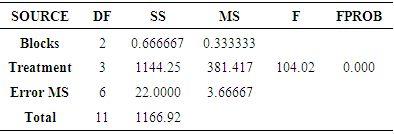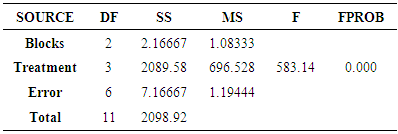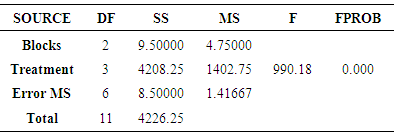-
Paper Information
- Paper Submission
-
Journal Information
- About This Journal
- Editorial Board
- Current Issue
- Archive
- Author Guidelines
- Contact Us
International Journal of Agriculture and Forestry
p-ISSN: 2165-882X e-ISSN: 2165-8846
2016; 6(2): 93-98
doi:10.5923/j.ijaf.20160602.06

Eucalyptus Leaf Powder is Effective in Maize Weevil Control
Emmanuel Mandudzi , Xavier Edziwa
Department of Technical Education, University of Zimbabwe, Harare, Zimbabwe
Correspondence to: Xavier Edziwa , Department of Technical Education, University of Zimbabwe, Harare, Zimbabwe.
| Email: |  |
Copyright © 2016 Scientific & Academic Publishing. All Rights Reserved.
This work is licensed under the Creative Commons Attribution International License (CC BY).
http://creativecommons.org/licenses/by/4.0/

An experiment was carried out at a research station to determine the effectiveness of different doses of Eucalyptus tereticornis leaf powder in controlling Sitophilus zeamais in stored maize grain. The experiment was laid out in a completely randomised design with four treatments that were replicated three times. The four treatments used were: no pesticide; 0.5g Super Shumba 200G/1kg grain; 5g eucalyptus leaf powder/1kg grain and 2.5 geucalyptus leaf powder/1kg grain. The study focussed on weevil mortality in treated samples as well the % grain weight loss only. The results of the experiment revealed that Eucalyptus tereticornis leaf powder has great potential to be used as a pesticide against Sitophilus zeamais in stored maize grain. However, regular application of the powder may be necessary as the efficacy of the powder gets low with time.
Keywords: Maize weevils, Botanicals, Eucalyptus leaf powder, Percentage grain loss, Weevil mortality, Stored maize
Cite this paper: Emmanuel Mandudzi , Xavier Edziwa , Eucalyptus Leaf Powder is Effective in Maize Weevil Control, International Journal of Agriculture and Forestry, Vol. 6 No. 2, 2016, pp. 93-98. doi: 10.5923/j.ijaf.20160602.06.
Article Outline
1. Introduction
- Post-harvest losses of grain are of great concern to all concerned with human food security. Rajashekar, Bakthavatsalam and Shivanandappa (2012), assert that worldwide losses of stored maize grain to weevils are approximately 10%. The writers postulate that the worldwide maize production per year is 130 million tonnes. It therefore means that 13 million tonnes of the total maize produced is lost to weevils each year. Very severe infestations can result in 90% grain loss (Coasta, 2014; Muzemu, Chitamba and Mutetwa, 2013). In Sub- Saharan Africa, an estimated 25 - 40% of grain crop is lost in stores each year due to weevil menace (Coasta, 2014). The losses directly affect the lives of millions of smallholder farming families. The losses include the direct consumption of the kernels and accumulation of webbing, hence loss of the food commodity in terms of quality and quantity (Rajashekar et al, 2012). These heavy losses can be minimised through the use of pesticides which are, however, expensive for small scale farmers and at times not environmentally friendly (Fusire, 2008; Rajashekar et al, 2012) because of their residual effects and danger to non-target species like bees and birds. Use of synthetics may also lead to pest resistance and resurgence (Mulungu, Lupanza, Reuben and Misangu, 2007).Health conscious and environmentalists, to date, are advocating for pest remedies that are not a threat to human health and the environment at large. It is of utmost importance that people use natural plant based insecticides (botanicals) in controlling weevils since they are easily available and cheap. Briskin (2000) postulates that plant based insecticides are preferred as they have little or no negative effect on agricultural environment. Botanicals are organic compounds, hence they do not dissolve completely in water therefore they do not pollute water as well as the environment. They are more readily biodegradable and are less likely to contaminate the environment (Rajashekar et al, 2012).The botanical ways of controlling these pests is not something new. Eucalyptus leaves have been used as grain protectants for quite some time (Muzemu et al, 2013; Chomchalow, 2003) but the leaves would be intact not in a finer consistency (powder form). It is to this effect that this study endeavoured to establish the doses of eucalyptus leaf powder that could be used in suppression of maize weevils by small-scale farmers. The study focussed on weevil population dynamics (weevil mortality) in treated samples as well the grain loss (% grain weight loss).
2. Materials and Methods
2.1. Research Location and Characteristics
- The experiment was carried out at Rattray Arnold Research Station which is situated 35 kilometres North East of Harare, Zimbabwe. The research station is located in the commercial farming area of Arcturus along Shamva road. The latitude of the area is 17° 40` S and its longitude is 31° 14`E.
2.2. Materials
- Untreated maize grain was sourced from the commercial maize produced at the station. A cultivar, SC727, commercial maize from the station was used. Dirt from the maize was removed through winnowing as suggested by Masiiwa (2004) and the grain further cleaned using a 1mm sieve mesh screen so as to remain with intact kernels. The maize grain was disinfected, by freezing for a period of seven days, in order to kill any live insects on and in it as recommended by Musundire, Mazodze, Macheka, Ngadze, Mubaiwa and Manditsera (2015). Moisture content for the maize was 12%. The Dickey John moisture meter was used for testing the moisture content of the maize grain that was used in the experiment. The maize grain was graded manually and cleaned of broken kernels and debris as suggested by Fekadu, Waktole, Dante and Santiago (2012). The maize grain was kept in a cool dry room to avoid accumulation of moisture. The mass of maize grain was weighed, using a Sartorius LC50 laboratory scale, at the beginning of the experiment as well as at the end of the experiment. This was meant to establish grain weight loss during the experiment.Fresh Eucalyptus tereticonis leaves were collected from a plantation at the research station. These leaves were let to dry under room temperature for 12 days. The leaves were later ground into powder using a mortar and pestle. The powder, so produced, was placed in polythene bags for safe keeping. A local commercial grain protectant was used as a control. Eucalyptus leaves are known to contain essential oils (citronella and 1,8cineole) which have some repellent and insecticidal properties (Song, Wang and Liu, 2009; Isiaka, Nureni, Kasali and Konig 2011). It was, however, beyond the scope of this study to determine the actual amount of essential oils that were in the leaves.Weevils were sourced from a pure colony maintained at the station. These insects were kept in glass jars with untreated maize grain. The jars were covered with cloth in order to restrict movement of the pests but allow aeration.
2.3. Experimental Design
- A completely randomised design (CRD) was used to arrange 1 kg packs of maize grain which were replicated three times. The experiment was a single variable one where other variables remained constant except for one variable, which was the amount of eucalyptus powder applied. There were four treatments:● 0.5g Shumba Super 200G/1kg maize grain (positive control - PC).● 2.5grams eucalyptus powder/1kg maize grain. Herein referred as EC2.5g.● 5grams eucalyptus powder/1kg maize grain. Herein referred as EC5g.● 1kg of maize untreated (negative control - NC). See Figure 1.
 | Figure 1. Randomised placement of the treatments in shelves |
2.4. Measurement of Parameters
- Weevil counts were done once in fourteen days up to the end of the experiment, that is, on day forty-two. Weevil mortality was assessed on days 14, 28 and 42 after the introduction of pests. This was done to establish whether insect infestation was increasing or decreasing per individual treatment. The numbers of live and dead pests were counted from each jar to obtain the adult weevil mortality. A white paper was used to cover the platform from where the counting process was to be conducted (Figure 2). This was done in order to make the identification of the pests easier. Weevils suspected to be dead were exposed to light so as to verify. Those that did not respond to the light and heat were further examined by prodding with a sharp object so as to make sure that the pests were really dead (Amenga 2011).
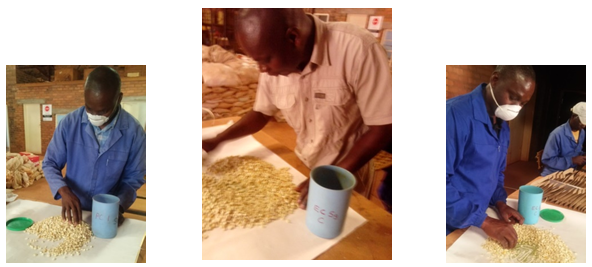 | Figure 2. Sample of weevil counting on days 14, 28 and 42 |
 | (1) |
 | (2) |
3. Results and Discussion
3.1. Weevil Mortality on Day 14
- There was a highly significant difference, among the treatments, for mortality on the 14th day after inoculation (Table 1 p < 0.001). The mortality percentage for the positive control was 93% with mean of 28, the negative control was 7% with a mean of 2, EC5g was 44% with a mean of 13.3 and EC2.5g was 23% (Figure 3).
|
 | Figure 3. Percentage distribution of weevil mortality on day 14 |
3.2. Weevil Mortality on Day 28
- There was a highly significant difference, among the treatments, for mortality on day 28 (Table 2 p< 0.001). There was 0% mortality in the negative control (NC). Instead of having mortalities, the number of insect pests was increasing since the insects were hatching. EC 5g had a mortality percentage of 26.7 (Figure 4). However, there was suppressed oviposition hence the pest numbers did not increase. EC2.5g had a mortality percentage of 22.3. Just like EC5g, it also suppressed oviposition of the insects as evidenced by a decrease in the number of insect pests. However EC2.5g’s effectiveness was less as compared to the positive control (PC) and EC5g.
|
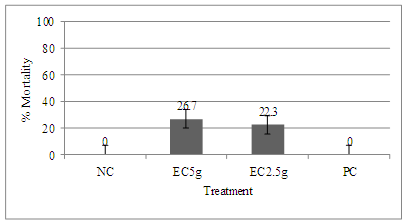 | Figure 4. Percentage distribution of weevil mortality on day 28 |
3.3. Weevil Mortality on Day 42
- On the 42nd DAT (day after treatment) of maize with eucalyptus leaf powder and synthetic pesticide, there was a significant difference between treatments for mortality (Table 3 p < 0.001) among the different doses of eucalyptus powder and the synthetic pesticide, EC5g and EC 2.5g had a mortality rate of 33% and 13% respectively (Figure 5). The synthetic pesticide recorded 0% since all the inoculated pests had been swiped out in the first 14 days hence it was the most effective. However the effectiveness of eucalyptus leaf powder could be enhanced if the doses are increased. This is shown in the relationship between the efficacy of EC5g and EC2.5g.
|
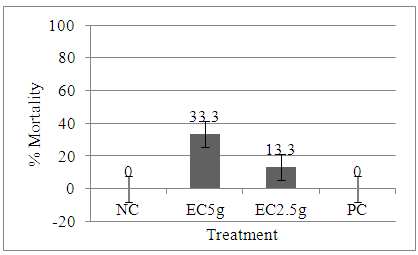 | Figure 5. Percentage distribution of weevil mortality on day 42 |
3.4. Grain Weight Loss
- There was a significant difference between the treatments for grain weight loss on the 42nd day after inoculation with a probability of (Table 4 p < 0.001). The percentage grain loss for PC was 0%. This was so due to the fact that all the insect pests were wiped out in the first 14 days hence they had not done any significant damage to the grain. As for EC5g and EC2.5g, there was damage done to the grain since the botanical control did not have instant effect but rather its effect was gradual .It was to this effect that there was grain loss of 0.5% and 0.8% respectively (Figure 6). However this could be improved if the eucalyptus doses are increased.
|
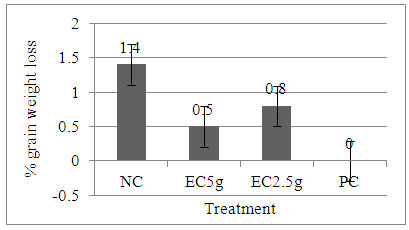 | Figure 6. Grain weight loss after 42 days |
3.5. Discussion
- The results indicated that Eucalyptus tereticornis leaf powder could be used to control Sitophilus zeamais in stored maize grain. On day 14 after treatment EC 5g/kg maize and EC 2.5g reduced the number of insect pests by 44.3% and 23.3% respectively. This echoes the postulation that essential oils from Eucalyptus tereticornis have carminative, insecticidal and anti- microbial properties hence could be used as a grain protectant since the oils can kill insect pests as well as prevent oviposition (Isiaka, Nureni, Kasali and Konig, 2011). Eucalyptus tereticornis leaf powder has a repellent effect on the olfactory and gustatory system of Sitophilus zeamais. The effectiveness of eucalyptus leaf powder could be due to the fact that as Sitophilus zeamais feed on the maize grain, they could pick lethal doses of the plant leaf powder thereby leading to stomach poisoning. The results of the current study also revealed that the relationship between leaf powder dose and its effect on insect pests is such that an increase in the dosage would lead to an increase in the mortality of the insect pests. This is clearly shown on the effect of EC5g and EC 2.5g on the 14th day after treatment. EC5g had an insect mortality of 44.3% whereas EC2.5g had 23.3%. This means higher mortality rates could be achieved through an increase in the dosage of the leaf powder. Thus, farmers could increase the doses of the leaf powder to enhance positive results.The results of the research on day 28 revealed no oviposition by weevils in EC5g and EC2.5g treatments. The numbers kept on decreasing instead of increasing. This could be because of the effects of the components of eucalyptus leaf powder of which one such component which could have a bearing on the decrease in the insect populations is 1.8-Cineole. Coats et al (2003) postulate that 1.8-cineole is a major constituent of the eucalyptus essential oils. They further assert that this important component is known to be toxic to Protephanus truncates and Sitophilus zeamais. Knight (2009) asserts that 1.8-cineole completely inhibits the development of eggs, larvae and pupae of Sitophilus zeamais. Thus, oviposition and subsequent progeny production are inhibited.There was a highly significant difference on the insect mortality on day 28 among the treatments. However the insect mortality on this particular day was lower than the one on day 14. This could be a pointer to the fact that the effectiveness of the eucalyptus doses decrease with time hence constant reapplication of the leaf powder could be necessary in order to attain good results. The negative control recorded 0% mortality on this day. Instead of reducing in number, the pests were increasing in number indicating that oviposition took place. In the positive control, EC5g and EC2.5g, the insect pests did not increase hence it could be used as a clear indicator that both the synthetic and the botanical control suppressed oviposition of the insect pests. Although EC5g and EC2.5g had a substantial effect on Sitophilus zeamais, the results of day 28 revealed that the amount of dose applied has a bearing on weevil mortality. Future research that comes up with the most ideal dose that produces best results for maximum grain protection are highly recommended, by this study. This study proposes that losses could probably be reduced through an increase in the rate and frequency of application. Frequent application would likely ensure continual protection of the stored maize grain.
4. Conclusions
- The present study has shown that eucalyptus leaf powder can be used as an alternative pesticide against Sitophilus zeamais in stored maize grain as was shown by the statistical weevil mortality for EC5g and EC2.5g. However the effectiveness of Eucalyptus tereticornis leaf powder on Sitophilus zeamais increases with the increase in the dosage. The results of the research revealed that doses play a pivotal role in as far as eucalyptus leaf powder’s effectiveness is concerned. The higher the doses the greater the efficacy and the opposite is also true. Therefore it simply means that if farmers are to realise meaningful stored maize protection, there is need to increase the eucalyptus leaf powder doses to the optimal. Since the effectiveness of eucalyptus leaf powder increases with the increase in the dosage, it therefore means there is need to experiment further to establish the most ideal and effective doses. Furthermore, the results of this research also revealed that the effectiveness of eucalyptus leaf powder decreases with time after application hence constant reapplication of the leaf powder is greatly recommended.
ACKNOWLEDGEMENTS
- The authors would like to thank Rattray Arnold Research Station members ofstaff for providing materials and equipment that was used in the study. All the equipment, grain and other materials were provided by the institution, while the chief researcher was on attachment.
 Abstract
Abstract Reference
Reference Full-Text PDF
Full-Text PDF Full-text HTML
Full-text HTML